October 19, 2012
This is quite a continental moment here on the Spiked Punch. First, tonight, like I usually do on the continent, I ate too much. Then, to combat my over-indulging, I had a healthy dose of Elisir di Salvia, a digestif I made from a recipe taken out of a simply-named book, Tisane, Liquori and Grappe. I have no idea who it’s by, but it’s from the Demera Company and is Italian (which means I translated the recipe. Yeah, I do everything for you. But you deserve it). I picked it up in a little tucked away bookstore in Sansepolcro’s historic center, called Arca Dei Libri. Nice place, really. Only blocks from the can’t-miss-it restaurant Fiorintino. Anywho, Elisir di Salvia is a curious mix of stuff, and the taste reflects it: herb and spice sweetness at the beginning, mellowing Marsala middle, totally different backend flavor and kick. At first, I wasn’t sold, but now I think it’s a weird kind of genius drink. And yes, I felt better after having it after eating too much. Oh, when in the jar cooling its heels, it looks like this:
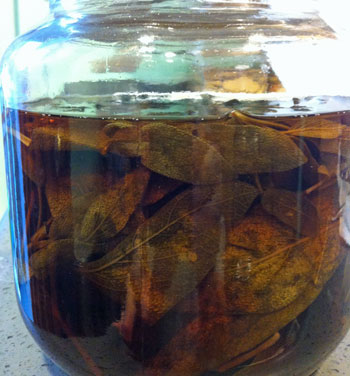
Elisir di Salvia
1 liter Marsala
1 cup fresh sage leaves
1 orange rind
2 cups high proof vodka or grain alcohol
1/2 cup warm water
1.6 cups sugar
1. Add the Marsala, sage, and orange to an airtight glass container airtight. Let sit for 10 days to two weeks. Shake at least once a day.
2. Dissolve the sugar in the water to make a syrup, let cool, and then add it and the vodka.
3. After 24 hours of rest (or a week, if you’re lazy like me), filter and transfer to a glass bottle. Take 1 shot from the liqueur in all cases of difficult digestion.
Tags: cocktail recipe, Cocktail Recipes, digestif, Elisir di Salvia, Friday Night Cocktail, homemade liqueurs, Italian digestif recipe, Italy, What I'm Drinking
Posted in: digestif, Italy, Liqueurs, Recipes, What I'm Drinking
May 8, 2012
 Walking along on a dusky springtime eve
Walking along on a dusky springtime eve
I heard a noise of a bear starting to grieve—
What was this? I didn’t believe
But it was my own stomach, to which nothing did cleave.
I noticed a candle in a local watering hole,
And headed in to save my soul
(as well as my innards, which seemed an empty bowl
that was collapsing inwards as if chewed by a mole).
I ordered a feast of courses untold,
First bread and cheese filled with blue and mold
Accompanied by flagons of gin made bold
by lime juice, maraschino, violette—served cold.
Next up were plates that would make Hercules strain,
Pastas, ensalatas, empanadas, like rain
Were served alongside even more delicious mains
and a giant bucket of chilled Champagne.
I ate more food than any ten men,
The waitress came back and I started eating again
Following greens with green beans and then
Moving on to the sweets, the creams, the puddin’s.
And then the foods hit my center like a roiling brick.
I groaned, I cursed, my over-eating anything but comic
As I contemplated erupting like a fresh oil derrick.
Was there anything that could undo my stuffed predic-
ament?
And then like an angel dressed purely in serge
The waitress appeared or seemed to emerge
From my over-full haze and said through my dirge:
Sir, what you need, is a quick Underberg.
She handled me a bottle, small and in brown paper,
Made a motion of drinking as if in quick prayer,
And I, trusting her angelic look and manner,
Unscrew’d the green cap and turned into a gulper.
The moment the elixir of ‘berg hit my tongue
I felt that perhap’ my indulgence might be undone.
The flavor was of herbs and of spices far-flung,
Backed by a muscular fu tied to a tougher kung
And when the liquid miraculous hit my tum-tum
It cut through the food pounding me like a drum.
It bounced through the sweets all the way to the bottom,
And left me feeling as if I’d barely eaten a crumb.
Oh, Underberg, the god’s must have made you
For people like me, those was are known to
Eat enough at one sitting to turn them near blue.
Oh, Underberg, you’ve made my evening less askew,
And for this I will never forget your wond’rous brew,
Your lovely taste, your dark and magic hue,
Your little bottles, your quick rescue
Of my evening—I’d call it voodoo
Underberg, if I didn’t believe it a higher urge.
And so I left that night without out having to purge,
swearing that, whether in Miami or Pittsburgh,
I would never again be without my savior, my Underberg.
November 30, 2011
 Whew, that’s a long title. But I wanted to make sure to get it all in there, so you didn’t just skip over this post like the others (I kid, I kid. I hope). The title really says it all: I’m hosting a class at the amazing Delancey Pantry, and the focus/menu/tippliciousness is an Italian Winter Cocktail one. What does that mean? Sign up for the class and find out, cutie. I can tell you a little more. First, the Delancey Pantry is the coziest spot for sitting around a table drinking and making drinks that you can think of, or that I can think of (it’s behind the pizza awesomeness of the Delancey itself, in Ballard, WA). Second, the four drinks we’ll be making are: Sicilian Sling, Negroni, Hanky Panky, and the Cynartown. Third, the Pantry is at: 1417 NW 70th Street, Seattle, WA. Fourth, the class takes place on Friday, February 10th, 2012 at 7 pm. So, c’mon, sign up today and be a part of it all, Italian style.
Whew, that’s a long title. But I wanted to make sure to get it all in there, so you didn’t just skip over this post like the others (I kid, I kid. I hope). The title really says it all: I’m hosting a class at the amazing Delancey Pantry, and the focus/menu/tippliciousness is an Italian Winter Cocktail one. What does that mean? Sign up for the class and find out, cutie. I can tell you a little more. First, the Delancey Pantry is the coziest spot for sitting around a table drinking and making drinks that you can think of, or that I can think of (it’s behind the pizza awesomeness of the Delancey itself, in Ballard, WA). Second, the four drinks we’ll be making are: Sicilian Sling, Negroni, Hanky Panky, and the Cynartown. Third, the Pantry is at: 1417 NW 70th Street, Seattle, WA. Fourth, the class takes place on Friday, February 10th, 2012 at 7 pm. So, c’mon, sign up today and be a part of it all, Italian style.
PS: Even if you don’t sign up, check out the Delancey Pantry website. Isn’t it lovely? It was done by Mr. Sam T. Schick, who should probably redo your website, too.
May 23, 2011
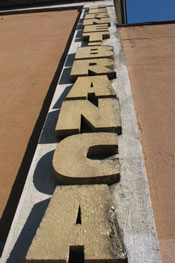 If you haven’t read Part 1 of our Branca Distiller tour, well, do so now. It talks lots about company history, the Collezione Branca, the Branca philosophy of novare serbando (renew but conserve), and much more. Go read it. Okay, are you back? Now we’re ready for Part 2, in which we actually get to walk around the distillery and see where the magic happens. Still with our tour guides Elisa, Marco, and Valeria, we last stopped at the Carpano area of the museum, where we learned more about Branca’s purchase of Carpano Antica (and the full Carpano family of vermouths), had a quick drink of Carpano Antica, and then got ready to hit the distillery proper. But first, as we’re walking into delicate areas, we had to suit up (attractive, aren’t we?):
If you haven’t read Part 1 of our Branca Distiller tour, well, do so now. It talks lots about company history, the Collezione Branca, the Branca philosophy of novare serbando (renew but conserve), and much more. Go read it. Okay, are you back? Now we’re ready for Part 2, in which we actually get to walk around the distillery and see where the magic happens. Still with our tour guides Elisa, Marco, and Valeria, we last stopped at the Carpano area of the museum, where we learned more about Branca’s purchase of Carpano Antica (and the full Carpano family of vermouths), had a quick drink of Carpano Antica, and then got ready to hit the distillery proper. But first, as we’re walking into delicate areas, we had to suit up (attractive, aren’t we?):
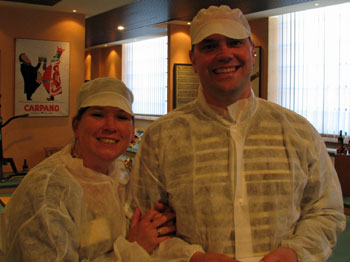
Check out the wonderful Carpano ad in the background, too. Yet another piece of Branca-related advertising I wish I had framed in my house. After suiting up, we started by going through a few doors into the Borghetti coffee liqueur room. Now, here’s where I have to admit one downside for you, dear readers, in this Part 2 of the tour post. We couldn’t, in most areas of the distillery, take pictures. As mentioned in Part 1, having delicious liqueurs, vermouths, and amaros means that folks are always wanting to know how you make them. Which means even someone as un-spy-ish as me (though I could be a spy, I suppose–I have that look, right?) can’t snap snaps. Borghetti, if you don’t know (and you might not, as it’s sadly not readily available in the States) is the coffee liqueur made by the Branca company. It’s a staple in Italy (all the everyday bars/cafes we’d visit had it, usually in both big bottles and in these small, 3-inch-ish, portable bottles), and I’m not 100% sure why we don’t have it in the U.S., as it’s scrumptious. Normally, I’m not either a big coffee liqueur fan or a big coffee drinker (a lot of coffee liqueurs taste ickily chemical to me), but I really love the Borghetti, and after seeing where it’s made, I know why. It only contains coffee (freshly roaster and made there), liquor, and a natural sweetener. Walking into the room where it’s made is somewhat like walking into the best coffee roaster inside Willy Wonka’s chocolate factory, as there’s a perfect sweet/coffee aroma—which matches Broghetti’s taste. Here’s what the bottle looks like, if you want to scoop some up on your travels:
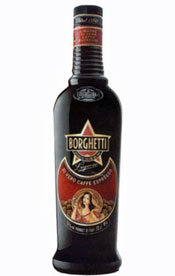
From there, we saw where the ingredients in Fernet Branca are treated during production (where the secret processes mentioned in Part 1 happen), including the big iron pot (pictured in Part 1) where the spices and more are stirred up. Amazing stuff, really, as it’s partially mechanized, but still there are always workers in attendance, watching over the process. We next went to perhaps my favorite part of the whole tour (well, just hanging out with our awesome tour guides was my favorite part, but this coming up was a close second), the cask where Stravecchio Branca spends time before bottling. Stravecchio Branca is the brandy made by the Branca company, and is another item I wouldn’t mind seeing more of over here (again, it’s in most bars/cafes in Italy and is a really good, full-bodied brandy). Here’s the bottle if you ever want to try some and you see it:
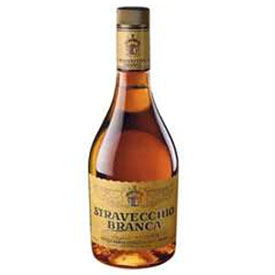
But the cask (or flask, as they referred to it as) in question we could take pics of, but we didn’t have a wide enough angle lens to do it justice. See, it’s the biggest cask in Europe, and was built over a two month time period way back in 1892. And it’s massive and astounding to stand in front of:
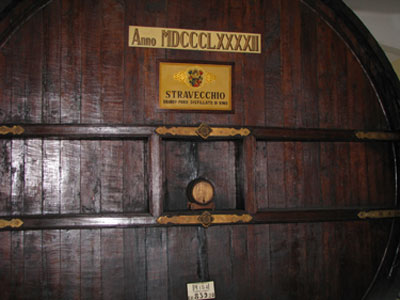
Stravecchio was originally called “Vieux Cognac,” but they had to change the name due to the Cognac rules (about it having to be made in the Cognac region of France, that is). Today, the brandy spends some time in other casks, but each batch spends a least some time in this massive cask–which is never empty, as some is always left in to ensure that the brandy stays consistent (a nice little touch). On the back of the ginormous cask, there’s a chart that tells how full it is (somewhat like the little marks made on the wall as kids get taller), alongside a little chalkboard notepad (which is alongside my head):
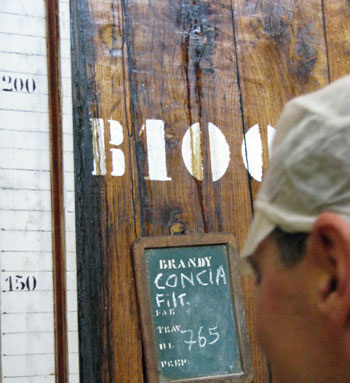
My favorite part of the photo (and another reason why I loved this cask so much) is right above the “B100” where the cask looks like it’s sweating. This is a slight oozing out that happens, about which Marco said, “it is crying.” He even wiped some off on a fingertip to taste, and encouraged us to do the same–which I, naturally did. It was super-brandy-charged, and I dug it so much I went back for more (hey, I have a hard time seeing anything cry). After the Stravecchio, we wandered down into the cellars, where we viewed wooden cask after wooden cask, rows of them (all lovely, by the way), first more brandy (they start here in smaller casks before moving to the biggest cask in Europe), then the wooden casks Fernet Branca is aged within. Fernet Branca has to be aged at least a year, and the brandy for three, so you can imagine that there are tons of casks (not to mention that Branca Menta is also made with aged Fernet Branca, on to which is added pure peppermint oil, sweetening, and love). All these hundreds of casks, the giant cask, the production facilities upstairs, the museum from Part 1, and the offices live in this one building, in the center of Milan, a bustling city. There’s something almost otherworldly about it, especially when wandering through the building’s many rooms and passages. One could easily get lost down here—you’d never go thirsty, luckily. Also luckily, we didn’t have to worry about getting lost, because we were with our friendly and knowledgeable (and fun) tour guides. Check them out, aren’t they great:
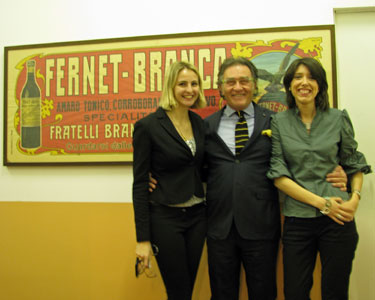
After seeing the casks, and saying our goodbyes, we walked out in Milan craving a little Fernet Branca or Branca Menta. Of course, we had a four-and-a-half hour drive ahead of us, so the cravings just became sharper, until we were back in our home Italian neighborhood, where we could indulge our Branca thirst at Bar Fizz. Thanks again Fratelli Branca Distillerie, we had a great time.
Tags: amaro, Borghetti, Branca Menta, Carpano Antica, Fernet Branca, Fratelli Branca Distillerie, Italian Liqueurs, Italy, Milan, Punt e' Mes, Stravecchio brandy
Posted in: Brandy, digestif, Fernet Branca, Italy, Liqueurs
May 20, 2011
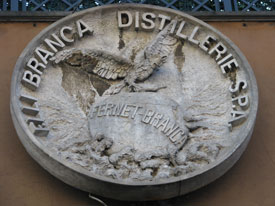 Back in April (when still living in Italy), wife Nat and I took the road north from our Italian pre-tirement home, driving up to Milan so we could make a visit to the Fratelli Branca Distillerie, where Fernet Branca and many other delicious drinkables are made. When we showed up in the morning for our tour, we weren’t sure at all what to expect—a little talking, a little walking around the building, we just didn’t know. But it ended up being an amazing day, where we learned a ton and had some fun (huge props to Laura Baddish for helping to set it up, too). Once past the guards (serious liqueurs always need guards at the gates, cause secret formulas are too tempting to weaker minded individuals), we were met by three swell Italian folks: Elisa, Marco, and Valeria. Marco gave most of the tour, with tons of expert translating (his English is better than our Italian, but not by enough to carry on in-depth conversations) and more touring by Elisa, with Valeria filling in the cracks.
Back in April (when still living in Italy), wife Nat and I took the road north from our Italian pre-tirement home, driving up to Milan so we could make a visit to the Fratelli Branca Distillerie, where Fernet Branca and many other delicious drinkables are made. When we showed up in the morning for our tour, we weren’t sure at all what to expect—a little talking, a little walking around the building, we just didn’t know. But it ended up being an amazing day, where we learned a ton and had some fun (huge props to Laura Baddish for helping to set it up, too). Once past the guards (serious liqueurs always need guards at the gates, cause secret formulas are too tempting to weaker minded individuals), we were met by three swell Italian folks: Elisa, Marco, and Valeria. Marco gave most of the tour, with tons of expert translating (his English is better than our Italian, but not by enough to carry on in-depth conversations) and more touring by Elisa, with Valeria filling in the cracks.
The tour started in the Collezione Branca, which is a museum created by the Branca family, a museum in the distillery (the aromas of Fernet Branca and other drinks waft up as you wander the museum), collecting Branca historical items, memorabilia, and more. It really serves as a tangible history of the company in many ways, and was full of intriguing artifacts. Right at the beginning are portraits of those family members who were there at the beginning, with a picture of Bernardino Branca in the middle:
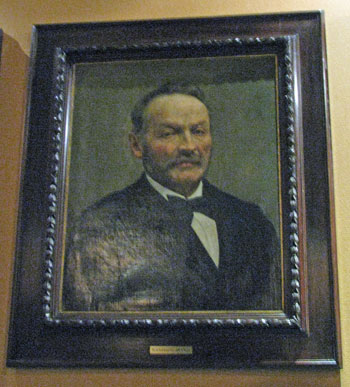
Bernardino was the original creator of the famous Fernet Branca, developing the formula with Dr. Fernet, a Swedish doctor, to assist malaria and cholera patients. With this aim, it was first tested in hospitals (where it was shown to help patients) and first sold in local farmacias, or pharmacies (quick aside: Italian pharmacists have a lot more leeway than those here in the States, in prescribing and diagnosing). The first cask that Bernardino made this herbal health mixture in is also in the museum, and lives right under his portrait:
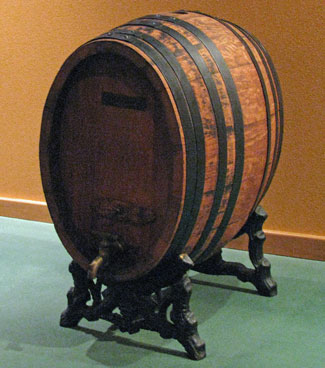
When walking through the museum, we learned more about the Branca family, which still runs the company today (the head of the company, Count Niccolo Branca, is the 5th generation of the family to make Fernet Branca). The family focus isn’t just with the Brancas, either, as our tour guide Marco is the 4th generation of his family to work at Branca (he’s been there since 1972). This lengthy dedication and devotion is quite remarkable, and shows in the end results: the liqueurs. There are lots more interesting family stories, such as those about Maria Scala, who married the third son of Bernardino and eventually became one of the first women in charge of a large company, and who originally developed the focus on continually creative Branca advertising—the company has always been on the forefront of advertising and advertising trends. One of my favorite, and a somewhat obscure, piece of marketing is this Branca suitcase:
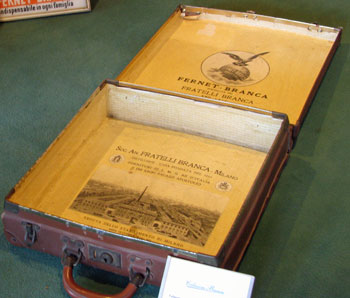
I would carry one of those in an instant (if you have one you’re tired of, please let me take it off your hands). The museum also has loads of production implements from the past, and some that were used in the past but are still utilized today, which points towards the Branca philosophy of novare serbando, or renew but conserve. For one example, Marco showed us these giant iron pots for herb maceration and heating, which are still used today, though the stirring is done mechanically instead of by hand:
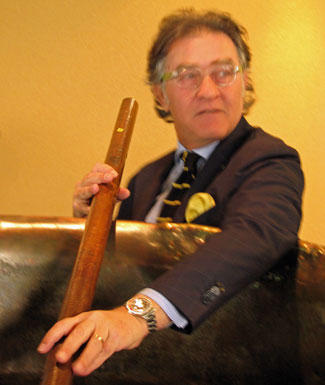
The pots were at one point stirred with both iron and wood stirrers (depending on the spices), and as the iron sticks were “cleaning” the pots, many thought that Fer-net came from some rendition of “clean iron.” Which is, I have to say, a great story. Fernet Branca gets its signature bitter, herbal, rich taste from an wide assortment of herbs, roots, spices, and other ingredients, and there’s a giant, mind-blowing, round table in the museum where you can see the complete layout of ingredients:
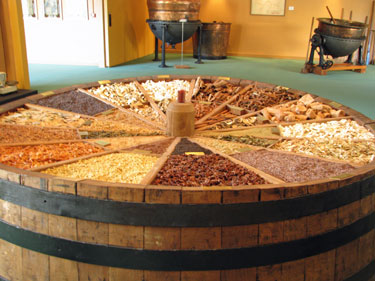
I knew (hey, I’ve done a little research before) that there were around 40 ingredients, and that the list included such far-reaching items as gentian root, rhubarb, myrrh, cinchona bark, galanga, saffron, and others, but I learned while there that all the products used are completely natural, and that all the suppliers have to sign a code of sorts, that says the products were obtained in a non-exploitive way. Another (and this was fascinating to me, but hey, I’m interested in odd things) fact I learned is that the real secret in the secret recipe for Fernet-Branca is how the ingredients are treated in production. Only the family knows, and the Count himself still does the treating (which means he has to go to the other distillery, in Argentina, regularly). Cool, isn’t it? After spices, we got to see tons of hip old Fernet-Branca ads, including the first one to use the eagle-over-the-world logo:
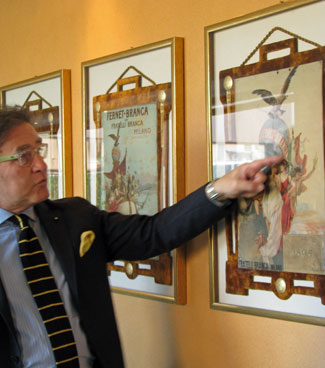
This logo was created in 1895, due to the large amount of Fernet Branca imitations being shuffled out of back alleys—always look for the eagle bringing the Branca over the world to ensure you get the real thing. There are a number of side rooms along the museum’s main path, where you can get a better picture of how Branca workers worked back in the day (as they say), with an herbalist’s room, chemist’s room:
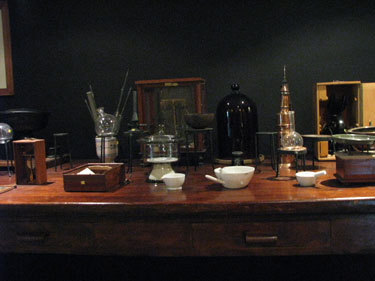
and more. The museum is persistent in remembering not just what was made, but those who made it—not to mention that the museum itself was built by current workers at the plant. Again, there’s that whole atmosphere of devotion to people and product, to stories and to history. After looking over the production process, the spices, and hearing about the history contained within, we walked into a room full of bottles, whole tables of old Fernet Branca bottles, and bottles of other products brought out by the company, including older bottles of Branca Menta (a minty-er and sweeter version of Fernet Branca released in 1965), bottles of Carpano Antica (Branca bought the Carpano company years ago in a particularly astute moment—Carpano Antica being the first Italian vermouth, and one still made partially by hand, and the Carpano company also making Italian vermouth Punt e’ Mes), and more bottles. There’s even a whole cabinet of Fernet Branca impersonators (I suppose success always leads to imitation):
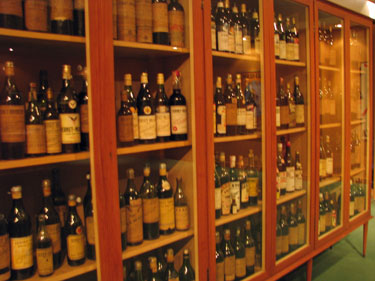
Then we stopped in the bar room (of course the museum was going to have a bar at some point), talked a bit more about advertising, had some Carpano Antica (which I loved even before stopping, and which I was happy to have a glass of even at 11:30 AM), and saw a host of happening ads for the non-Fernet-Branca-Branca brands. If the tour ended now, I would have been more than happy–but we still had the actual distillery to see! Which I’ll talk more about in Part 2, so come on back. Oh, first, check out this sweet and colorful Punt e’ Mes ad (one of about, say, 96, that I wished I had on my walls at home):
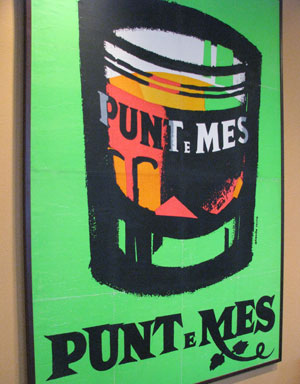
Tags: amaro, Branca Menta, Carpano Antica, Fernet Branca, Fratelli Branca Distillerie, Italian Liqueurs, Italy, Milan, Punt e' Mes
Posted in: Cocktail Art, digestif, Drinks on the Road, Fernet Branca, Italy, Liqueurs
July 2, 2009
It’s a holiday weekend, and you wanna get to it (hopefully yours starts on Friday, like mine), and I wanna get to it, but before then, I wanna drop a quick bit of holiday party science on you. You’re gonna eat too much this weekend (I’m also going for as many “nna” words a possible), but don’t wanna feel like the Blob (the fatty super villain, not the bubbly asteroid spin off). Which is why you should have the fixin’s for a Stomach Reviver on hand, cause it’ll cure your aching tummy, and let you have more fun-na. It goes like this:
Ice cubes
1-1/2 ounce brandy
1 ounce Kümmel
1/2 ounce Fernet Branca
2 dashes Peychaud’s bitters
1. Fill a cocktail shaker half way with ice cubes. Add everything. Shake, strain into a cocktail glass or straight down the ol’ feed hole.

It’s the double bitters (FB and Peychaud’s) I believe, that alleviates that over-full feeling. At least it did for me the other night, after I’d consumed like six pieces of pizza, some salad, a few bread sticks, and probably some ice cream. Who can remember everything? Anyway, I was out of Kümmel (that caraway-and-sometimes-fennel-flavored treat), and so used homemade fennel liqueur, and it went down like a good date gone south. Wait, that sounded bad. I meant that it was really a touch sweet (but not too much) on the front end, and then a touch bitter at the end. I like that. You should too. If you don’t have Kümmel, play around with subbing in another sweetish spiced liqueur, and let me know how it treated you, and what you’re gonna call it (besides wonderful relief, that is).
PS: Check out that rad antique’y shaker I picked up not long ago. It pours like a little teapot. That got tall.
April 21, 2009
Buon giorno pals (or buona serra, depending on what time of day your blog reading takes place). As anyone who read this blog post knows, I was recently in Italy for a couple weeks with wife Nat and some pals, and while there I had some, well, absolutely positively fantastico eats and drinks. And, lucky for you, I took pictures (and Nat took some, too), so you can experience the experience a little (and maybe plan a trip of your own). I’m going to do two things to relay trip gastronomic and alcoholic information in a more friendly fashion. First, I’m gonna break it up into three posts (or maybe more, but at least three): Bologna, Florence, and the countryside (which for the purposes of me in Italy is the Upper Tiber Valley area that covers a bit of southeast Tuscany and northwest Umbria). Second, I’m going to attempt to be a little less wordy, though I know, know, know (like a chant, that is) it goes against my personal wordy grain. But hey, what the heck.
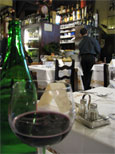 So, to start, Bologna. Also known as Bologna la grassa, or Bologna the fat, due to its traditional place as a food center in Italy (if not the food center). We showed up and instantly loved it, with its arcades (nice to walk under when it’s raining), and red-hued architecture, and churches, and markets, and, especially with its food and drinks. We had our favorite meal of this trip while there, at a restaurant called De Cesari, at Via de’ Carbonesi, 8. Family owned and around for over 100 years, it’s a lovely little spot. All the produce comes from the family farm, and they even make their own wine. On the drink side we started with prosecco, then had the house lambrusco, which was full-bodied and lightly frizzante.On the food side, it was Sformatino con Formaggio al Tartufo (for A.J.–though we shared) and Crostata di Zucca (for Natalie). The sformatino was a light, cheesylicious pair of soufflé-esque creations topped with truffles (the sformatino was a little more dense, in the best way, than a regular soufflé, and so intense in taste):
So, to start, Bologna. Also known as Bologna la grassa, or Bologna the fat, due to its traditional place as a food center in Italy (if not the food center). We showed up and instantly loved it, with its arcades (nice to walk under when it’s raining), and red-hued architecture, and churches, and markets, and, especially with its food and drinks. We had our favorite meal of this trip while there, at a restaurant called De Cesari, at Via de’ Carbonesi, 8. Family owned and around for over 100 years, it’s a lovely little spot. All the produce comes from the family farm, and they even make their own wine. On the drink side we started with prosecco, then had the house lambrusco, which was full-bodied and lightly frizzante.On the food side, it was Sformatino con Formaggio al Tartufo (for A.J.–though we shared) and Crostata di Zucca (for Natalie). The sformatino was a light, cheesylicious pair of soufflé-esque creations topped with truffles (the sformatino was a little more dense, in the best way, than a regular soufflé, and so intense in taste):
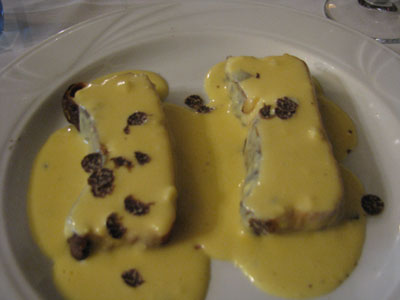
and the crostata was a savory pumpkin pie that was out-of-this-world. Creamy but lush and full of flavor:
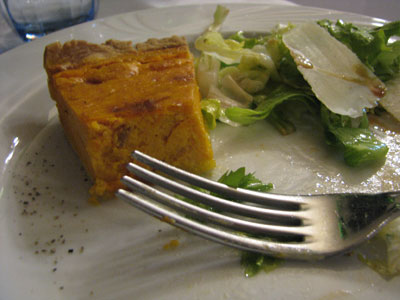
For our main courses, I had the Ravioli di Zucca, which was homemade ravioli stuffed with pumpkin. Fairly unadorned (just a brush of olive oil and freshly grated pecorino), this is, to me, pasta at its best–because the taste of the pasta is good enough to be allowed to strut its stuff, and then the stuffing busts through:
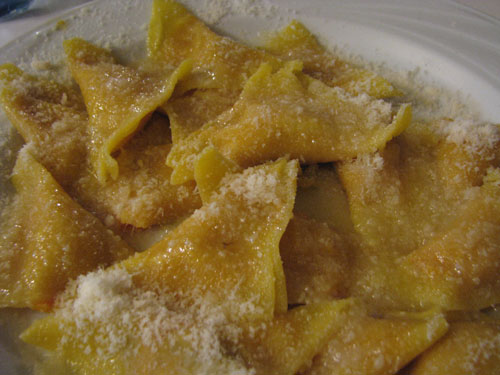
Nat had the Tortelloni di Ricotta al Burro Fuso e Parmigiano, which was also scrumptious, like bundles of cheesy joy wrapped in perfectly made and cooked pasta. But, as good was the pasta was, we definitely couldn’t stop there (we’re long-haul eaters), and so ordered up the cheese place, which boasted six different goat cheeses of varying strength and flavors, served alongside a fig compote that was figgy sweet with that thickness all jams strive for–a combination splendid enough to drive eaters mad with joy:
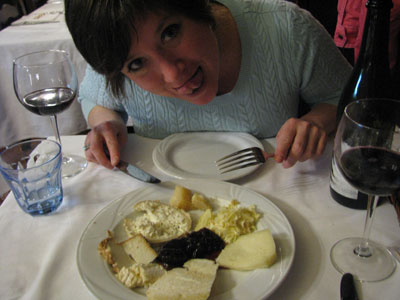
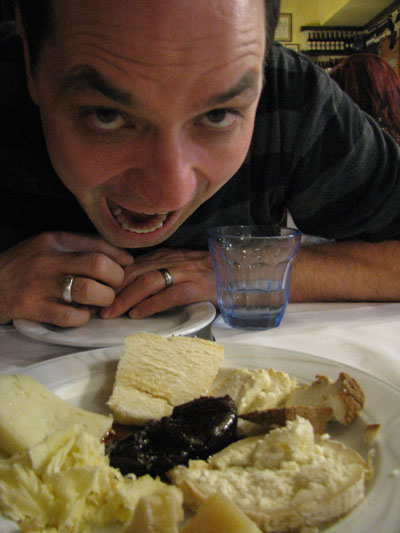
And then, to add to our little culinary heaven, we had the chocolate tort. Now, if we would have ended it all then, and called it a night, this would still be one of my favorite meals on the trip (and perhaps of all time).
 But we asked friendly waiter Gaetano for limoncello and amaro, to aid the digestion (a healthy practice I tend to practice), and when he reported that they were out of limoncello, he offered us some of the house digestif. You know (if you know me at all) that the phrase “house digestif” drives me mad, mad, mad with happiness I tell you. It came out in a bottle that had a block of ice frozen around it, and in the ice were fruits, flowers, herbs, and such. Amazing! But the digestif itself was even better, a blueberry-infused grappa, with strong berry overtones and that grappa kick and personality underneath (and served with, catch this, chocolate covered orange peels, mini biscotti, and raisins). If you go to Bologna and don’t visit De Cesari, well, you have only yourself to blame. Get on a plane. Go there now.
But we asked friendly waiter Gaetano for limoncello and amaro, to aid the digestion (a healthy practice I tend to practice), and when he reported that they were out of limoncello, he offered us some of the house digestif. You know (if you know me at all) that the phrase “house digestif” drives me mad, mad, mad with happiness I tell you. It came out in a bottle that had a block of ice frozen around it, and in the ice were fruits, flowers, herbs, and such. Amazing! But the digestif itself was even better, a blueberry-infused grappa, with strong berry overtones and that grappa kick and personality underneath (and served with, catch this, chocolate covered orange peels, mini biscotti, and raisins). If you go to Bologna and don’t visit De Cesari, well, you have only yourself to blame. Get on a plane. Go there now.
And then for your next meal, stop by the charming Osteria La Mura, at Vicolo del Falcone, 13/A (which is right across from the hotel we stayed at and heartily recommend, San Mamolo), owned by Peppino, who is welcoming, affable, witty, and happy to pour you a Strega when you wander in at 1 am:
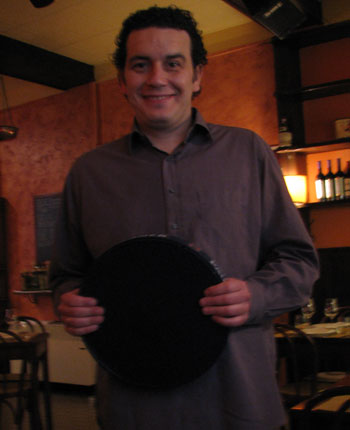
The nicest guy in Bologna, I believe. We had lunch at La Mura (the day after the late-night Strega), and it was as tasty as Peppino is friendly. We started with Caprese salads, and the fresh bufala mozzarella was rich and creamy and cuddled up with pals tomato, basil, olive oil, and pepper:
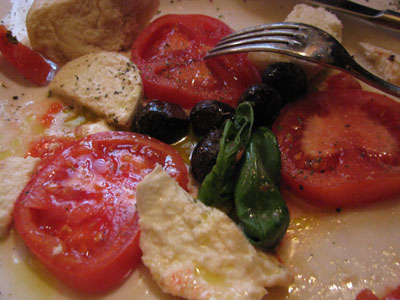
Then, we dove into plates of Gnocchetti Sardi al Cavofiore, which is a bit hard to describe but luscious to eat: like a gratin of mini gnocchi, finely chopped cauliflower, herbs, and cheese, with a touch of crisp on the top edges:
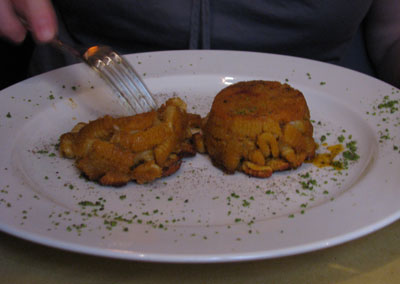
And if that wasn’t a grand enough way to start the day (remember, the night before, 1 am, Strega, equals sleeping late), Peppino brought us out his trio of house digestifs: plum, orange, and basil. In beautiful little bottles, and bursting with fresh fruit and herb flavors (again with a touch of ka-pow due to the grappa undertones, which also add a bit more flavor, too), these helped give us the jump start we needed:
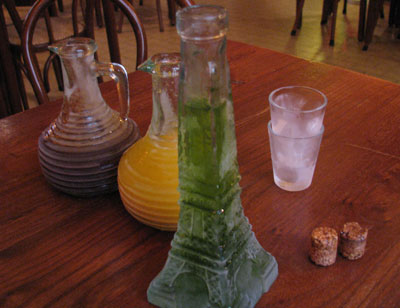
Just thinking about those meals makes me want to grab a taxi, race to the airport, scrounge a ticket to Bologna, and pray I can get in to each restaurant without a reservation. We had other good meals, snacks, and drinks, in Bologna, as well, but since this post is longer than Sookie’s tail already, I’m going to rest on the above laurels. Oh, with two more quick shout outs. We stopped multiple times at Pasticceria D’azeglio, on Via Massimo Dazeglio, which was right around the corner from our hotel (there are two versions, and I suggest the smaller one), for bubbly spritzes (prosecco and Aperol and an orange slice) in the afternoons (accompanied by a mini-buffet of snacks the bartenders would always whip out). I with no reservations recommend this afternoon practice no matter where you are:
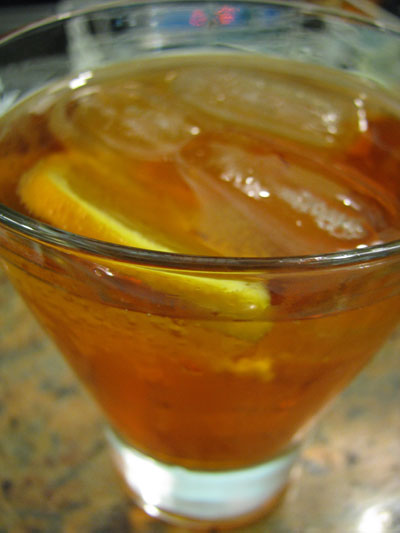
And, finally, a sort-of fist-shaking-while-laughing nod to the cozy and hippish Rosa Rosae, Via Clavature, 18/b, where we ordered spritzes but got espressos, which we then drank out of honor (I mean, they made them for us). And now Nat has the espresso monkey firmly attached to her back:
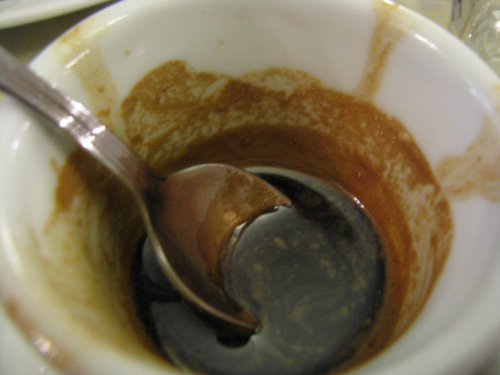
Ciao bellas, until Italy-on-the-road-take-two.
Tags: Aperol, Bologna, De Cesari, digestif, espresso, grappa, homemade liqueurs, Italian spritz, Lambrusco, Osteria La Mura, Prosecco
Posted in: Bars, Bologna, Champagne & Sparkling Wine, digestif, Drinks on the Road, grappa, Italy, Liqueurs, Uncategorized, What I'm Drinking























































